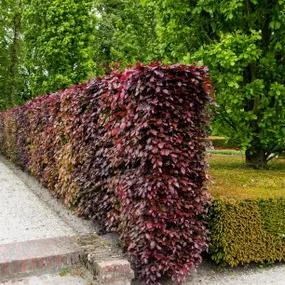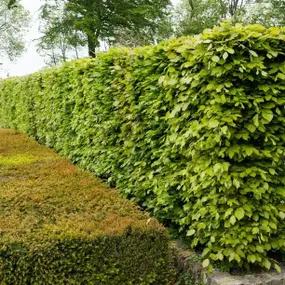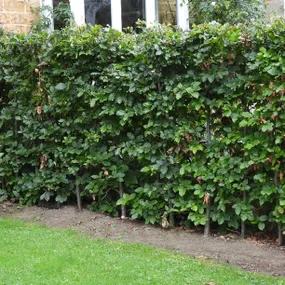Beech Plants Delivered in Large Sizes
Order Potted Beech & Troughs Now For August Delivery
Pre-Order Bareroot Beech For 2025/26 Winter Season
What is Beech Hedging?
Beech, Fagus sylvatica, is one of the best loved formal hedging plants in the UK, and it also makes a wonderful stock proof, livestock friendly hedge for enclosing stables and studs, often planted on top of bunds and traditional Devon banks.
It is not evergreen, but a clipped beech hedge will hold onto its Autumn leaves through most of the winter, giving you privacy and interest almost year round.
Copper / Purple Beech is more dramatic, a bit more expensive and probably adds more value.
Green Beech is an easier backdrop for most flower beds, and so more versatile.
• Uses: Formal and stock-friendly hedges from 100cm upwards.
• Good Points: Native, holds leaves in winter, clips beautifully.
• Position: Anywhere with good drainage and light.
We also sell Green & Purple Beech trees in standard sizes.
How many Beech hedge plants do I need?
The planting density for your Beech hedge depends on the purpose:
- For a normal garden boundary hedge, plant at 3 plants per metre (every 33cm) in a single row.
- A stock-proof country hedge requires 2 staggered single rows (i.e. start one row 16.5cm after the other), with 40cm between rows. That works out at 6 plants per metre in total.
- An interior hedge for purely decorative purposes can be planted at 2 plants per metre (every 50cm) in a single row.
What size Beech hedge plants should I buy?
- If you are not in a hurry to get a full sized beech hedge, we recommend starting with smaller sizes: up to 60cm tall.
- If you are in a hurry and need instant impact, or are filling gaps in an existing hedge, then of course pick the biggest size that fits your budget.
Smaller plants are cheaper, easier to plant, and tend to establish better because they are dug up with most of their roots intact.
You can also clip them attentively and ensure a very bushy plant from the base up.
If you still aren't sure, then 60/80cm tall is considered the ideal compromise between price, size, and waiting time until you get a mature hedge.
Your mail order beech hedge plants are delivered by next working day courier.
If there is anything wrong with your plants when they arrive, Contact Us within 5 working days, and our friendly support team will sort it out.
All bareroot plants are covered by our Refund Guarantee, so you can give them a whirl with complete confidence.
What is the difference between Copper / Purple Beech and Green Beech?
Purple (AKA copper) Beech is the same as Green Beech in all respects apart from the leaf colour.
Purple Beech leaves actually start off mostly green in Spring, although a good bit darker green than Green Beech, maturing through a range of winey-maroon colours to luxurious deep purple, turning marmalade orange in Autumn.
Green Beech leaves emerge bright green in Spring, which look divine with the sunlight filtering through them. They mature to a glossy mid-green in Summer, followed by a vibrant coppery-yellow colour in the Autumn, a touch brighter than Purple Beech.
Both varieties will hold their Autumn foliage (which is brown by this point) through most of the Winter, provided that they were clipped at least once during summer.
What is the difference between Beech and Hornbeam?
Green Beech, Fagus sylvatica, and Hornbeam, Carpinus betulus, are unrelated but similar looking when grown as a hedge.
Basically, Beech is best, but if it's not suitable for your location, Hornbeam is a pretty close substitute.
Difference in Appearance:
- Beech is definitely the most popular due to its faster growth and more beautiful, smooth green leaves, which hang onto the branches through most of Winter
- Hornbeam leaves are wrinkled, a more muted shade of green, and only remain on the branches for part of the Winter.
Difference in Growing Conditions:
- Beech really needs plenty of sun and well drained soil: it does not perform well in the shade, nor in damp soils that waterlog in Winter.
- Hornbeam pretty much grows anywhere, and is definitely suitable for shady sites and damp soils.
If there are puddles of rainwater where you are going to plant your hedge 12-24 hours after heavy rain, the ground is probably too wet for beech.
Where can I grow a beech hedge?
You can grow a Beech hedge in any well drained soil, including chalk, poor soils, and heavy clay as long as it is not waterlogged in Winter.
It does need a decent amount of sun: light shade is fine, but it won't thrive in less than half a day of full sun.
Beech is very hardy and wind-resistant, but not suitable for the coast.
For shady and/or damp conditions, we recommend Hornbeam hedging as the closest substitute.
How long does a beech hedge take to grow?
Beech plants are moderately vigorous, growing at 30-60cm per year, depending on your location (plants generally grow faster in the warmer South & West than in the cooler East & North of Great Britain) and your local conditions (wind-shelter and full sun are ideal).
However, as with any hedge, you must trim it to get lots of dense, bushy growth down to the base. So, there is a balance to be struck: aim for about 20cm of growth after trimming in the first few years.
Bear in mind that it is common for most plants to put on very little height in their first year after being transplanted into your garden.
There is nothing wrong with this: they are laying down roots first, in readiness for growing upwards and filling out.
How big does a beech hedge grow?
A beech hedge can be maintained from about 1 metre up to as tall as you like: the tallest beech hedge in the world is 30 metres tall.
When and How do I plant a beech hedge?
You can plant beech hedging at any time of year, except when the soil is frozen.
The best time to plant beech is in winter (November to March), using bareroot stock, which is cheaper, easier to carry and plant, and tends to establish even better than the pot grown equivalents.
Spacing a Beech Hedge:
Beech and Hornbeam look better in late Winter as a staggered double row: 50cm between plants along each row, so 4 plants per metre in total.
But a normal single row at 3 plants per metre is fine, especially when the hedge will be allowed to grow reasonably wide, at least 150cm at the base.In some counties, Beech is used on farms as a livestock proof hedge, planted like other country hedging in a double row: two single rows in parallel, 40cm apart. Stagger the rows by starting one 16.5cm after the first.
Planting Instructions:
To plant a beech hedge using bareroot plants up to 80cm tall or less, follow the slit planting instructions in our country hedge planting video with one difference: do not cut the plants in half as you would with country hedging. Only snip off the tips - the top inch is plenty.
You will need spiral guards and canes to support them if you have rabbits around.
The mypex weed suppression fabric is optional, and really not necessary in most garden.
To plant a beech hedge using potted plants, or bareroot plants over 80cm tall, follow the trench planting instructions in our formal hedge planting video.
We always recommend using Rootgrow friendly fungi, especially if your soil is poor.
Essential Aftercare:
Water well after planting, and consistently during the first summer. A porous hose will make the job easier.
Keep the ground under your new hedge clear of weeds.
Remember: the two biggest causes of new hedges failing are drying out, and/or being choked by weeds.
How & When do I Clip / Trim and Prune my Beech Hedge?
The biggest question everyone has is: when do I cut my mature beech hedge to make it hold its Autumn leaves through Winter?
The answer is between late July and early September: anytime in August is best. Read more below.
How & When to trim a new Beech hedge
New beech hedges only need very light trimming.
You may lightly trim your plants immediately after planting, nipping the leading leaf buds on top of every stem, but you don't need to.
Pruning back straggling, untidy stems is enough.
- After they grow for a season, lightly trim them in late autumn.
- Remove the leaf buds at the end of the stems, don't cut them back hard.
- Trim 1-2 inches off the top, and keep the sides in line.
Year 1: While your beech hedge is still establishing, it's best to trim it in winter. One light cut, just nipping off the ends of the new growth is all it needs.
Year 2: Now the hedge is really established, it should grow faster: you might give it a light clip in midsummer, and another in winter.
After two years of formative clipping, a regularly trimmed beech hedge, clipped lightly twice a year, will remain lush for decades.
How & When to trim a mature Beech hedge
You can trim your hedge at any time without harming it, but for the best foliage display, trim twice a year, with an optional third trim:
- First trim of the year: Around late May - early June. This keeps your hedge bushy.
- Second trim of the year: In August. This produces a late flush of new leaves, which will stay on the branches through winter.
- Optional: Anytime your hedge looks untidy, which can happen in warm humid weather that encourages growth, trim to restore a neat shape.
The ideal hedge profile is slightly tapered, like / \ but with less steep sides, so that light can reach the lowest branches.
If your hedge runs east-west, its south facing side gets full sun and could be vertical, like this: | \
Why do I have to trim my Beech Hedge at all?
By trimming your new beech hedge plants early and often, you force them to branch out.
The more side branches there are, the more leaves you get, and the nicer your hedge looks.
If you don't trim your beech hedging, it will turn into a row of beech trees!
When you plant trees close together, they naturally compete for light by growing straight up. Compare a beech tree in a dense wood to one standing alone in a park:
- The parkland tree is spreading and dome shaped, with many low side branches.
- The woodland tree is upright, relatively slender and has few or no low side branches.
By clipping the hedge, we maintain dense growth with lots of leaves down to the ground, with a shape that allows light to the lowest branches.
When and How do I prune an old Beech hedge?
An overgrown or sparse old beech hedge that needs serious remedial pruning is best done in winter, when the plants are dormant, spread over 2 or 3 years.
Note that being so cautious is for best results, to ensure strong regrowth, and to prevent you from looking at a mostly bald hedge for a year!
If you were to do all the pruning described below in one winter, the hedge should be fine, especially with watering the following summer (a severe prune followed by a dry summer could be too much stress).
Hard Pruning Instructions: The 'better safe than sorry' way
The summer before cutting it back, it is good to mulch your hedge well, and clip it as normal.
Water well in dry spring and summer weather following a severe pruning.
- First winter: reduce the height by up to 40% - 30cm below your desired height is ideal.
If it is still right at, or above your desired height, then reduce it more next winter.
If you don't need to remove much up top, then go straight to step 2: - Second winter: Hard prune the branches on the sunniest side to within 30cm (12") of the main trunks in the middle of the hedge, and lightly trim the other side as normal.
- Third winter: Hard prune the other, shadier side the same way as above, unless recovery is slow, in which case delay for a further 12 months. Trim the other side as normal.
- You should now have a balanced hedge with bushy regrowth all over. Small bald patches should fill in over time as the new branches bush out: be sure to clip at least twice a year going forward.







